There are a whopping 59 native snakes in Arizona. The Grand Canyon State ranks highly on the list of states with the most endemic snake species. On top of this, there are a handful of non-native species that call this state their home.
Some of these snakes are venomous, while others are completely harmless. Some of them even make popular pets. What they all have in common, however, is that they all call Arizona their home and are an important part of its ecosystem.
With almost fifty different snake species in the State, there is a lot to unpack. So let’s dive right into it!
Table of Contents
Snakes in Arizona
1. Western Diamondback Rattlesnake
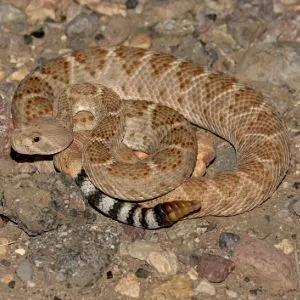
- Experience Level: N/A
- Family: Viperidae
- Scientific Name: Crotalus atrox
- Other Names: Texas diamondback, adobe snake, Arizona diamond rattlesnake, coon tail, spitting rattlesnake, buzz tail
- Adult Size: 4ft
- Lifespan: 15-20 years
- Price Range: $125
This Arizona native is a record-holder – the western diamondback rattlesnake is responsible for the highest number of snake-related deaths in the United States (not something we’d brag about, to be honest).
It mainly inhabits the southwest of the continent and isn’t too picky when it comes to its surroundings. From deserts to pine-oak forests, the western diamondback lives anywhere where it can feed on small mammals – mice, rats, prairie dogs, squirrels, and the like.
The venom of this snake works by destroying the tissues of its prey, affecting muscles, veins, and even the heart. If left untreated, there is a 10-20% chance the bite will have a fatal consequence for humans.
2. Southwestern Speckled Rattlesnake

- Experience Level: N/A
- Family: Viperidae
- Scientific Name: Crotalus pyrrhus
- Other Names: bleached rattlesnake, pale rattler, pallid rattlesnake, red rattlesnake, white rattlesnake
- Adult Size: 3 ft
- Lifespan: 10-15 years
- Price Range: N/A
The southwestern speckled rattlesnake comes in a variety of colors, from light gray to red. The phenomenon is thought to originate from the snake’s need to blend in with its surroundings, but it has also made this species a relatively popular pet, although it is illegal to keep in Arizona.
In fact, the species’ desirability as a pet has led to certain color varieties being considered “collectible”. This is mainly true for lighter-colored specimens. Luckily, so far it seems that the trend hasn’t pushed the species towards becoming endangered.
While adult southwestern speckled rattlesnakes mostly feed on small mammals, young specimens enjoy snacking on other reptiles, mainly lizards. The venom of this species is not as toxic as that of the western diamondback, but it is still not harmless.
3. Northern Black-Tailed Rattlesnake

- Experience Level: N/A
- Family: Viperidae
- Scientific Name: Crotalus molossus molossus
- Other Names: black-tailed rattlesnake
- Adult Size: 30-42 in
- Lifespan: 15-20 years
- Price Range: N/A
As the name suggests, this species is characterized by black scales on its tail around the rattle. Much like the previous entry on the list, it comes in a wide variety of colors. For example, black-tailed rattlesnakes that inhabit the area around Phoenix tend to be brown with hints of yellow or green.
During the course of a year, the behavior of the black-tailed rattlesnake changes. In spring and fall, they tend to be more active during the day, but they turn nocturnal in summer to avoid the heat (yes, the Arizona sun is too much even for cold-blooded reptiles). In winter, they hibernate.
If there’s something this species is great at, it’s getting around. Depending on the type of terrain they’re on, they will either sidewind it or move in a straight line. On top of that, they are great climbers and even better swimmers.
4. Tiger Rattlesnake

- Experience Level: N/A
- Family: Viperidae
- Scientific Name: Crotalus tigris
- Other Names: N/A
- Adult Size: 18-36 in
- Lifespan: 20-25 years
- Price Range: N/A
If you thought the western diamondback was scary, wait till you meet the tiger rattlesnake. Although not as prolific of a killer, this species has the second-most toxic venom in the world of rattlesnakes. On the bright side (for us, not for the snake), it doesn’t produce a lot of it.
The patterns on the snake’s back resemble tiger stripes (hence the name) that fade out as they get closer to the head. Speaking of the head, the species is the smallest-headed one among rattlesnakes. On the other hand, its rattle can get quite big.
Although this species is not considered endangered, its natural habitat is slowly shrinking due to urbanization. On top of that, the skin and rattles of rattlesnakes are sold as souvenirs. This may lead to a change in the species’ status in the future.
5. Sidewinder
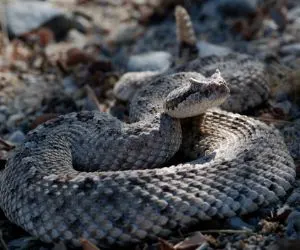
- Experience Level: N/A
- Family: Viperidae
- Scientific Name: Crotalus cerastes
- Other Names: horned rattlesnake, sidewinder rattlesnake
- Adult Size: 17-30 in
- Lifespan: 5 years (up to 20 in captivity)
- Price Range: N/A
The sidewinder rattlesnake got its name after its unique way of locomotion. Sidewinding includes bending the body in S and J shapes in order to move sideways. This helps the snake move more quickly on sandy terrain, but it also ensures that it doesn’t touch the hot ground for extended periods with any part of its body.
Aside from its unusual movement, the sidewinder is easily recognizable by its “horns” – raised scales above its eyes designed to protect the eyes from the sun and sand. The species comes in colors that resemble its surroundings – cream, brown, and gray, usually with a white belly. They might also change color depending on the temperature.
The sidewinder is a mainly nocturnal species during the summer, and diurnal during the rest of the year. When young, they use their tail to lure prey (mostly lizards), while adult snakes mostly feed on rodents.
6. Mojave Rattlesnake
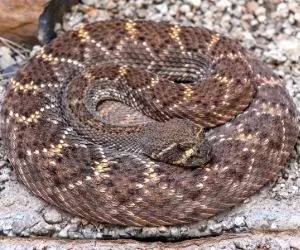
- Experience Level: N/A
- Family: Viperidae
- Scientific Name: Crotalus scutulatus
- Other Names: Mojave green, Mojave green rattlesnake
- Adult Size: 3 ft
- Lifespan: 24 years
- Price Range: N/A
The only rattlesnake whose venom is more toxic than the tiger rattlesnake’s is the Mojave green. Aside from being highly toxic, its venom is also deceptive – it causes a delayed onset of symptoms, which may lead the bitten person to believe they’re not in danger. Luckily, with proper medical attention, chances of survival are very high.
In appearance, the Mojave rattlesnake is very similar to the western diamondback. It is usually tan to brown with diamond-shaped blotches of a darker shade along its back. The main difference between the two is that this species’ venom attacks the nervous system, as opposed to muscle tissue.
The Mojave green can be found throughout most of Arizona. It also inhabits southern California, southern, northern, and eastern Nevada, a small part of Utah, southern New Mexico, and Texas. It is also a relatively common sight throughout Mexico.
7. Arizona Black Rattlesnake

- Experience Level: N/A
- Family: Viperidae
- Scientific Name: Crotalus cerberus
- Other Names: black rattlesnake, black diamond rattlesnake, Cerberus rattlesnake, brown rattlesnake
- Adult Size: 31-43 in
- Lifespan: 12 years
- Price Range: N/A
As you may have guessed, the Arizona black rattlesnake is mostly black to dark brown in color with rectangular patterns of lighter shades. Adult snakes have less prominent patterns than juveniles, and it is even believed that they can change colors in a manner similar to chameleons.
The species is unusually social for a snake. After giving birth to live young, female snakes stay with them for up to two weeks, but it is interesting that they will sometimes help and get help from other new mothers.
The black rattlesnake usually avoids densely populated areas and will bite people only if it feels threatened. Its venom mostly affects the muscles and blood vessels. Although the potency of the venom is not too high, black rattlesnakes tend to produce a lot of it, which can lead to serious symptoms that require medical attention.
8. Twin-Spotted Rattlesnake
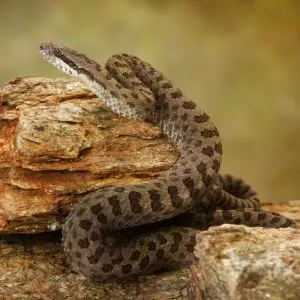
- Experience Level: N/A
- Family: Viperidae
- Scientific Name: Crotalus pricei
- Other Names: Price’s rattlesnake, Arizona spotted rattlesnake
- Adult Size: 20-24 in
- Lifespan: 16 years
- Price Range: N/A
The twin-spotted rattlesnake got its Latin name (pricei) after field biologist William Wightman Price who was the first one to collect specimens for research. Its English name comes from brown spots and a dark line running along the middle of its back.
The venom of the twin-spotted rattlesnake is very toxic. Despite the usually low venom quantities, the bite of this species should always receive immediate medical attention. Luckily, the odds of running into the twin-spotted rattlesnake are pretty low unless you’re out looking for it.
The species only inhabits very limited areas in southeastern Arizona and some areas in Mexico. It sticks to high elevations covered in rock slides, forests, or grassland. Like other rattlesnakes, this species feeds on rodents and birds, but it is one of the few that practices cannibalism if necessary.
9. Banded Rock Rattlesnake
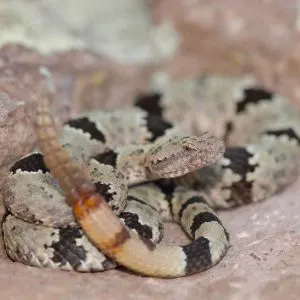
- Experience Level: Expert
- Family: Viperidae
- Scientific Name: Crotalus lepidus klauberi
- Other Names: rock rattlesnake, blue rattlesnake, green rattlesnake, green rock rattlesnake
- Adult Size: 24 in
- Lifespan: 30 years in captivity
- Price Range: $250
The banded rock rattlesnake is a smaller rattlesnake species easily recognizable by darker horizontal stripes along its back combined with darker specks. The color between these stripes – or bands – is usually light gray.
The banded rock rattlesnake is born without a developed rattle. It only gets its first rattle segment after the first shedding, but can’t really make a sound with it before developing the second segment. During this time, the young communicate with their mother through tail movements that basically act as Morse code.
This species can be quite secretive – it is relatively small, fast, and difficult to spot, so there is still a lot we don’t know about them. For example, we do know that a very high number of them live in protected areas, but their population in the wild is still a mystery.
10. Arizona Ridge-Nosed Rattlesnake

- Experience Level: N/A
- Family: Viperidae
- Scientific Name: Crotalus willardi willardi
- Other Names: Willard’s rattlesnake
- Adult Size: 1-2 ft
- Lifespan: 21 years
- Price Range: N/A
If this species sounds familiar, it’s probably because it is the official reptile of the state of Arizona. It mostly inhabits the Sky Islands region, i.e. the far southeast of the state. It got its Latin name after businessman Frank Cottle Willard, who discovered the species.
The common name of the species, ridge-nosed rattlesnake, comes from two prominent ridges (raised scales) on both sides of its nose. It is generally brown in color with lighter horizontal stripes along its body and very prominent white stripes on its head.
The Arizona ridge-nosed rattlesnake is good at hiding, and it’s probably for the best because it’s not too confrontational. If this species feels threatened, it will usually run away and hide, rather than attack. And even if it doesn’t, the good news is that its venom isn’t all that potent or harmful to humans.
11. Desert Massasauga

- Experience Level: N/A
- Family: Viperidae
- Scientific Name: Sistrurus catenatus edwardsii
- Other Names: Edward’s massasauga, Edward’s rattlesnake
- Adult Size: 21 in
- Lifespan: 20 years in captivity
- Price Range: N/A
The desert massasauga is a relatively small rattlesnake with a light gray, tan, or white base color and large darker blotches. This also includes two elongated stripe-like blotches around the eyes. It can be confused for a prairie rattlesnake if you don’t look too closely.
The species prefers arid and semiarid rocky areas, and it mostly sticks to desert grasslands. It can be found in Arizona, New Mexico, and western parts of Texas, although it is also known to inhabit some parts of Mexico.
Since the species is pretty rare in Arizona, it has a protected status, which means that hunting, collection, or any other form of harassment are against the law. Unfortunately, such a low population also means that we don’t know much about them. The lifespan of the species in the wild is unknown, although it is speculated that they rarely survive over the age of five.
12. Great Basin Rattlesnake

- Experience Level: N/A
- Family: Viperidae
- Scientific Name: Crotalus oreganus lutosus
- Other Names: great basin western rattlesnake
- Adult Size: 26-48 in
- Lifespan:17 years
- Price Range: N/A
The great basin rattlesnake comes in a wide range of colors and patterns, from dark gray to almost white, and from prominent dark patterns to barely visible patterns. Just as wide is their habitat – Arizona, California, Nevada, Utah, Idaho, and Oregon are all states this species calls home.
The great basin rattlesnake has keeled scales with ridges. It is also recognizable by three or more scales between its nostrils. Lastly, some specimens have very pronounced stripes on their faces.
The species prefers high deserts and rocky outcrops. They can usually be found at an elevation of around 8,000 ft. In Arizona, this means that they usually stick to the northwestern corner of the state, in the Arizona Strip region.
13. Grand Canyon Pink Rattlesnake
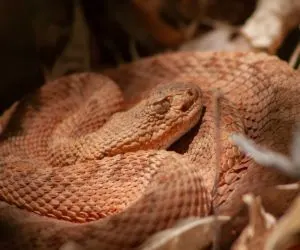
- Experience Level: Expert
- Family: Viperidae
- Scientific Name: Crotalus oreganus abyssus
- Other Names: canyon bleached rattlesnake
- Adult Size: 16-54 in
- Lifespan: N/A
- Price Range: $250
The Grand Canyon rattlesnake is so closely related to the great basin rattler that many scientists no longer consider it a subspecies at all. On the other hand, others consider it a completely separate species (get it together, scientists!). This snake, however, almost exclusively lives around the Grand Canyon area and is not such a common sight.
The Grand Canyon rattlesnake is also almost exclusively lighter in color than the great basin rattler. It comes in shades perfect for hiding in the sandy and rocky terrain of the Canyon with a sandy-brown base, brown blotches, and a darker tail. It also tends to be pretty skittish, which makes it even harder to notice.
The species is very agile and moves quickly without much trouble. Because of this and its shy nature, most people don’t notice it even if they do encounter it. While it’s unlikely to attack, its venom is highly toxic, so if you do happen to see one, it would be best to stay away.
14. Midget Faded Rattlesnake

- Experience Level: N/A
- Family: Viperidae
- Scientific Name: Crotalus concolor
- Other Names: faded rattlesnake, yellow rattlesnake
- Adult Size: 29 in
- Lifespan: N/A (assumed to be around 18 years)
- Price Range: N/A
Another subspecies of the western rattlesnake, the midget faded rattlesnake is generally smaller than its cousins. Even their babies are smaller – a newborn midget rattlesnake is only around 3 inches long. It is tan to brown in color with darker blotches that often fade over time, sometimes even completely.
But don’t be fooled by this species’ small size. Its venom, known as the concolor toxin, can be highly toxic. As a matter of fact, it is among the most toxic venoms in North America and may even be stronger than Asiatic cobra’s venom. The amount of venom the faded rattler produces varies from one snake to another. Still, it’s not a risk we’d take.
Just as small as its body is the faded rattlesnake’s habitat in Arizona. It only lives in a short and narrow strip around the northern border. Aside from AZ, the species can be found in the basins of the Colorado River and Green River, as well as all the way in southern Wyoming.
15. Prairie Rattlesnake

- Experience Level: Expert
- Family: Viperidae
- Scientific Name: Crotalus viridis viridis
- Other Names: Hopi rattlesnake
- Adult Size: 3-4.5 ft
- Lifespan: 16-20 years
- Price Range: $125
You may have heard stories of prairie rattlesnakes getting along (and even living together) with prairie dogs and burrowing owls. The truth is quite the opposite – these are often the species’ favorite items on the menu. What’s more, after eating or chasing them away, prairie rattlesnakes will often steal their homes, too.
The prairie rattlesnake is a common occurrence in northeastern and central Arizona. It’s not too picky when choosing where to live – in fact, this is the only venomous snake inhabiting Canadian prairies, but can also be found as south as Mexico.
Although it prefers land, the prairie rattlesnake is not afraid of heights either and often climbs trees. It will eat anything from mice to birds, but won’t shy away from eating other snakes if push comes to shove.
16. Sonoran Gopher Snake

- Experience Level: Intermediate
- Family: Colubridae
- Scientific Name: Pituophis catenifer affinis
- Other Names: Sonoran gophersnake
- Adult Size: 4-6 ft
- Lifespan: 15 years
- Price Range: $40-$200
Like a breath of fresh air, we’ve finally come to the first snake on our list that isn’t venomous. This is probably for the best since the Sonoran gopher snake is commonly found in golf courses, gardens, backyards, and sometimes even homes.
What they lack in venom, Sonoran gopher snakes make up for in aggression. They can be quite snappy and defensive, although it’s not completely impossible to tame them. They are a great natural means of pest control since they primarily feed on small rodents, such as mice.
One of the Sonoran gopher snake’s most distinct features is its tail. Aside from a lack of rattle (which is important, since they are commonly mistaken for their rattler friends), the distinctive features are lively yellow and black stripes or blotches, often with white outlines, which are in stark contrast to the brownish shades on the rest of the body.
17. Glossy Snake

- Experience Level: Beginner
- Family: Colubridae
- Scientific Name: Arizona elegans
- Other Names: faded snake
- Adult Size: 30-50 in
- Lifespan: 4-18 years
- Price Range: $40-$100
For the most part, the glossy snake looks like a washed-out Sonoran gopher snake, which is how it got one of its common names – faded snake. It comes in a variety of brown and tan shades. Their scales are smooth and shiny without a ridge.
Although they are completely harmless to people, they don’t seem to realize that, because the glossy snake will try to bite if it feels threatened. They also don’t seem to be aware that they aren’t rattlesnakes, because they sometimes rattle their tails as a warning sign. Basically, they’re the chihuahuas of the herptile world.
Much like their Sonoran cousins, glossy snakes are nonvenomous, and they mostly feed on lizards. They breed in spring and summer and have anywhere from three to over 20 juveniles. During the winter, they hibernate.
18. Sonoran Lyresnake

- Experience Level: Intermediate
- Family: Colubridae
- Scientific Name: Trimorphodon lambda
- Other Names: Sonoran lyre snake
- Adult Size: 2.5 ft
- Lifespan: 5 years
- Price Range: $180
Although they are distant cousins of the previous two entries, Sonoran lyre snakes are actually venomous. But even if you encounter one (which isn’t too likely to happen), there’s no reason to worry – their venom isn’t potent enough to harm humans. At most, there will be some mild pain around the area of the bite.
The Sonoran lyre snake is pretty narrow with horizontal lines, both lighter and darker than its base color – all along its body. On its head, these lines assume an arrow-like shape. Some say that this shape resembles that of a lyre harp, which is how the species got its name.
This snake is mostly nocturnal. During the day, it hides in crevices and under rocks. It is usually active between April and October, and it spends the rest of the year hibernating. Although it usually sticks to the ground and rocks, it can climb trees if it has to.
19. Sonoran Mountain Kingsnake
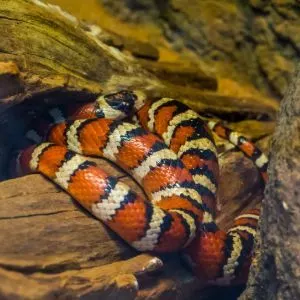
- Experience Level: Beginner
- Family: Colubridae
- Scientific Name: Lampropeltis pyromelana
- Other Names: Arizona mountain kingsnake, Pyro mountain kingsnake
- Adult Size: 3 ft
- Lifespan: 10-15 years
- Price Range: $185
The Sonoran mountain kingsnake likes to stand out. In the sea of brown snakes, this species decided to take its style in a completely different direction – it is bright red with over 40 white rings with black outlines. Its head is usually black, with a white-to-yellow nose. In other words, the Arizona mountain snake is a trend-setter, not a trend follower.
On a more serious note, the bright colors are most likely a defense mechanism called visual aposematism. Another defense mechanism the Sonoran mountain kingsnake uses is a very unpleasant odor it releases when in danger.
Like most other snakes on this list, the Sonoran mountain kingsnake feeds on small mammals, lizards, and birds. However, unlike other kingsnake species, this one doesn’t eat other snakes – that’s just a line it won’t cross.
20. Ring-Necked Snake
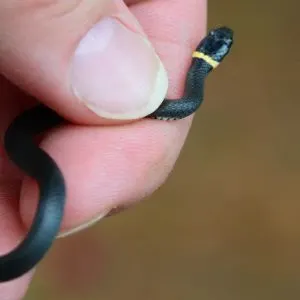
- Experience Level: Intermediate
- Family: Colubridae
- Scientific Name: Diadophis punctatus
- Other Names: ringneck snake
- Adult Size: 10-15 in
- Lifespan: 20 years
- Price Range: $30
Another species with a different (and great, we might add) sense of fashion, the ring-necked snake is one of the most unique snake species in the world. At first glance, it might seem pretty ordinary – just a black snake with an orange ring around its neck. But when the ringneck snake feels threatened, it reveals its brightly-colored yellow-to-red belly.
Just like with the Sonoran mountain snake, this unique coloration is a form of self-defense. Instead of running away or hiding, the snake will coil its tail to reveal the bright colors. This is basically supposed to tell the predator: “Hey, I’m not as harmless as I look!”
Although aggressive with predators and prey, the species is pretty social among themselves. They often bundle together when hiding, and sometimes, several mothers will lay clusters in the same nest.
21. California Kingsnake

- Experience Level: Beginner
- Family: Colubridae
- Scientific Name: Lampropeltis californiae
- Other Names: N/A
- Adult Size: 4 ft
- Lifespan: 10-15 (up to 40 in captivity)
- Price Range: $120-$190
The California kingsnake is easily recognizable by its dark (black or dark brown) and light (white or cream) horizontal stripes. They are very commonly found all over Arizona. It is not unheard of for them to make their way into people’s homes.
This snake might be harmless to humans, but it has definitely earned its royal title in the reptile world. Not only is it immune to most snake venoms, but rattlers won’t even attempt to rattle their tails in their presence.
If you ask us, that’s enough to establish dominance, but the California kingsnake would disagree. Not only does the species not see other snakes as a threat – it sees them as a meal. Aside from rodents, lizards, birds, and frogs, the California kingsnake will often feed on both venomous and nonvenomous snakes.
22. Desert Kingsnake

- Experience Level: Beginner
- Family: Colubridae
- Scientific Name: Lampropeltis splendida
- Other Names: N/A
- Adult Size: 3-4 ft
- Lifespan: 12-15 years
- Price Range: $90-$200
The desert kingsnake is usually black to dark brown with yellow patterns. These patterns are made up of smaller differently colored speckles which gives the snake a chainmail effect. Despite the name, it doesn’t only live in deserts – it is a pretty common occurrence in mesic habitats.
Just like its Californian cousin, the desert kingsnake feeds on other snakes, namely rattlers. Because of this, some people keep them in their backyards to fend off more dangerous and venomous intruders.
The desert kingsnake is native to Arizona, New Mexico, and Texas. In Arizona, it is naturally found only in the far southeastern corner of the state and is rarely seen west of Tucson or north of Safford.
23. Desert Nightsnake

- Experience Level: N/A
- Family: Colubridae
- Scientific Name: Hypsiglena chlorophaea
- Other Names: Desert night snake
- Adult Size: 2 ft
- Lifespan: over 10 years
- Price Range: N/A
Night snakes are very commonly found inside homes, and this includes the desert night snake. They usually make their way inside through pipes and end up in people’s sinks and bathtubs. They are small, nonvenomous, and harmless to humans. In fact, they are so harmless that they probably won’t even try to bite you.
You could really call this species the pacifist of snakes. When it feels threatened, it won’t run away, hide, or attack. Instead, it will ball up and hide its head underneath its body. Basically, in the fight or flight lottery, the desert night snake got the worst draw – freeze.
But don’t get confused – the desert night snake might seem skittish, but it feeds on one of mankind’s most feared arachnids – scorpions. Other items on their menu include spiders, salamanders, small snakes, and mice. They subdue their prey using weak venom.
24. Chihuahuan Nightsnake

- Experience Level: N/A
- Family: Colubridae
- Scientific Name: Hypsiglena jani
- Other Names: Chihuahuan night snake, Texas night snake
- Adult Size: 10-16 in
- Lifespan: 12 years in captivity
- Price Range: N/A
The Chihuahuan night snake looks pretty much the same as the desert night snake, with slight differences in color and the pattern on their heads. However, the areas these two species inhabit in Arizona practically don’t overlap – desert night snakes can be found in western areas and far northeast, while Chihuahuan night snakes mostly live in eastern areas excluding the far northeast and southeast corners.
The species, as the name suggests, is active mostly during the night, when it hunts for lizards. It will also occasionally eat other snakes and even insects. They subdue their prey using venom. Unlike most other snakes on this list, this one doesn’t feed on mammals, as its venom does nothing to them.
The Chihuahuan night snake can’t harm humans. Although we’ve already established that its venom isn’t effective on mammals, this isn’t the only reason why they’re not a threat. The mouth of this species is simply too small for it to be able to effectively harm a person. On top of all that, it doesn’t deliver venom through fangs – it is the saliva that is slightly venomous.
25. Three-Lined Boa

- Experience Level: N/A
- Family: Boidae
- Scientific Name: Lichanura orcutti
- Other Names: N/A
- Adult Size: 2.5 ft
- Lifespan: 15-20 years
- Price Range: N/A
Until recently, the three-lined boa wasn’t seen as a separate species but was classified as a type of rosy boa (lichanura trivirgata). In fact, there is still a lot of disagreement, both among scientists and hobbyists, about whether the three-lined boa should be given a separate taxonomy.
The name of the species is pretty self-explanatory – it has three dark brown to red stripes that run from the head to the tail, with lighter, white-to-yellow areas in between. They have a rounded tail and a relatively wide body.
The three-lined boa is found in the westernmost parts of Arizona – from the town of Kingman all the way to the southern border of the state. They are usually most active in early spring and can be seen during summer nights. However, they are generally a very rare sight in Arizona.
26. Rosy Boa

- Experience Level: Beginner
- Family: Boidae
- Scientific Name: Lichanura trivirgata
- Other Names: N/A
- Adult Size: 17-34 in
- Lifespan: 15-20 years
- Price Range: $75-$400
The only visible difference between the rosy boa and the three-lined boa is that the rosy boa is, well – rosy. The three stripes that run along its body are much lighter in color, ranging from pinkish to light gray. The areas in between are white to tan.
The species spends most of its time hiding under rocks and in crevices. They hibernate in winter and breed in spring. Usually, the mother will bear around six live baby snakes in one brood. They are often bred in captivity for the purposes of the pet trade.
Rosy boas feed on small mammals, for the most part, namely mice and rats. However, if they can’t find any, they will settle for an occasional lizard, bird, or frog. They are extremely slow, so they can’t really chase their prey. Instead, they either ambush or stalk it.
27. Groundsnake
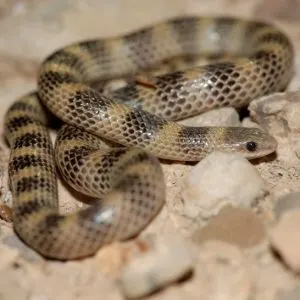
- Experience Level: N/A
- Family: Colubridae
- Scientific Name: Sonora semiannulata
- Other Names: ground snake, western ground snake, variable ground snake, miter snake
- Adult Size: 9-18 in
- Lifespan: N/A
- Price Range: N/A
Ground snakes are tiny species that can be very difficult to recognize. This is because their appearance can vary to a great degree. Some ground snakes are striped, some are solid-colored, and some are banded. They can be red, brown, or orange, with patterns varying from black to light red.
The species prefers rocky terrains with little water. That is likely the best way to identify them – their geographic range. In Arizona, they can be found in areas ranging from the far southeast of the state to the western counties. They usually don’t inhabit the northeastern part of the state.
The ground snake mostly feeds on invertebrates, such as spiders, centipedes, scorpions, crickets, and larvae from various insects. However, since they’re so small, sometimes, the predator can become the prey. The giant desert centipede, for example, has been observed feeding on ground snakes.
28. Variable Sandsnake

- Experience Level: N/A
- Family: Colubridae
- Scientific Name: Chilomeniscus stramineus
- Other Names: variable sand snake, banded sand snake
- Adult Size: 7-11 in
- Lifespan: 4 years
- Price Range: N/A
This tiny species is one of the smallest ones in the Southwestern U.S., and it rarely grows to be over a foot long. Its body is pretty thick considering its length and is usually covered in black bands with a yellow or orange base color. There is also a solid-colored sub-variety.
The sand snake is mostly active at night or during rains. It burrows and hides during the day. The species is also good at swimming thanks to its nasal valves, which prevent it from breathing in water, smooth scales, and concave belly.
The variable sand snake lives near drainages and in sandy areas where it can burrow for grasshoppers, roaches, and other prey. In Arizona, it inhabits the southern and central parts of the state.
29. Western Shovel-Nosed Snake

- Experience Level: Intermediate
- Family: Colubridae
- Scientific Name: Sonora occipitalis
- Other Names: western shovelnose snake
- Adult Size: 10-17 in
- Lifespan: N/A
- Price Range: $70-$200
The western shovelnose snake is a small species that usually has a combination of several colors distributed in bands that encircle the back of its body. Usually, these bands come in black with shades of yellow and orange as the base.
The name comes from the flat and slightly upturned tip of the snout that they basically use as a shovel for burrowing. They are really good at moving through sand thanks to their strong bodies (especially considering their small size).
During the day, the western shovel-nosed snake is usually buried under a thin layer of sand. At night, it comes out to feed. Its favorite snacks include insects (and their larvae), spiders, centipedes, and scorpions.
30. Long-Nosed Snake
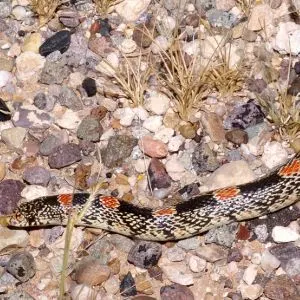
- Experience Level: Expert
- Family: Colubridae
- Scientific Name: Rhinocheilus lecontei
- Other Names: N/A
- Adult Size: 30 in
- Lifespan: 10-19 years
- Price Range: $70
The long-nosed snake has an elongated snout (who would’ve guessed) and usually comes in a combination of three colors. The base color is usually cream to yellow with saddles (blotches of color in a shape that resembles a saddle) of a darker color, usually black, dark brown, or reddish, and cream-colored spots.
The long-nosed snake is basically harmless. It is nonvenomous and almost never bites. However, it does have an effective defense mechanism. Whenever this snake feels threatened, it will emit an unpleasant odor, defecate, or even bleed from its anus. If we were a predator, it would definitely deter us.
Long-nosed snakes are a common encounter in most of Arizona, especially in the central and southwestern parts. They are common visitors in people’s homes, especially during the monsoon season, when they’re still young.
31. Coachwhip

- Experience Level: Expert
- Family: Colubridae
- Scientific Name: Masticophis flagellum
- Other Names: red racer
- Adult Size: 4-6 ft
- Lifespan: 15 years
- Price Range: $50-$100
Coachwhips are long, thin snakes with large eyes. They are also commonly known as red racers, owing to their surprising speed. They have good sight and are sensitive to their environment. They get alerted at the smallest sign of danger.
Unlike most other species on our list, the coachwhip is primarily diurnal – it is active during the day. It skillfully hunts small rodents, birds, lizards, other snakes, and bugs. The coachwhip subdues its prey by biting and holding onto it.
Coachwhips are generally considered harmless to people, although they might bite (but are more likely to run away). They’re nonvenomous, so unless the bite wound gets infected, there is no reason to worry. Despite popular belief, a coachwhip will not chase you if you encounter one, it might just happen to be running away in the same direction as you.
33. Western Patch-Nosed Snake

- Experience Level: N/A
- Family: Colubridae
- Scientific Name: Salvadora hexalepis
- Other Names: western patchnose snake
- Adult Size: 20-46 in
- Lifespan: 14 years
- Price Range: N/A
The western patch-nosed snake usually has a tan to light brown base with dark, often black vertical stripes running along its body. Its nose has a big scale in the shape of a guitar pick that comes in handy when digging sand and hunting lizards.
You can most commonly encounter this snake in the early morning or late afternoon and evening on hiking trails. However, western patch-nosed snakes are very skittish, so there’s a very low chance you’d get to take a good look at it.
There are three subspecies of the western patch-nosed snake present in Arizona: the Big Bend patch-nosed snake, the desert patch-nosed snake, and the Mojave patch-nosed snake.
33. Saddled Leaf-Nosed Snake

- Experience Level: N/A
- Family: Colubridae
- Scientific Name: Phyllorhynchus browni
- Other Names: saddled leafnose snake
- Adult Size: 6-15 in
- Lifespan: N/A
- Price Range: N/A
This small species mainly inhabits semi-urban areas around the cities of Tucson and Phoenix. Its base color is usually cream or tan, with a number of saddle-shaped blotches of a darker brown shade. The tip of its nose has a leaf-shaped scale used for digging in the sand.
The species likes desert scrub and semi-desert grassland. They are active between March and November, with peak activity happening from June to August. They almost exclusively come out at night and stay in hiding during the day.
The saddled leaf-nosed snake doesn’t really walk the talk (yes, we know snakes don’t exactly walk, but slither the talk doesn’t have the same ring to it, does it?). If it feels threatened, it will hiss and pretend to strike while not even opening its mouth. Seriously, put at least some effort into it!
34. Spotted Leaf-Nosed Snake

- Experience Level: Intermediate
- Family: Colubridae
- Scientific Name: Phyllorhynchus decurtatus
- Other Names: spotted leafnose snake
- Adult Size: 12-20 in
- Lifespan: N/A
- Price Range: $50
The saddled leaf-nosed snake’s close cousin, the spotted leaf-nosed snake can be recognized by the size and shape of the blotches on its back. While the former has regular saddle-shaped blotches, the latter has smaller, irregular-shaped ones. The spotted leaf-nosed snake also has noticeably more blotches.
Much like its cousin, the spotted leaf-nosed snake is completely harmless to humans. However, it’s not uncommon for people to get scared because it also has a habit of faking attacks and aggressively hissing when it feels threatened.
The spotted leaf-nosed snake mainly feeds on lizard eggs and lizards, its favorite meal being banded geckos. It is usually active at night and generally very good at hiding, which is why it was falsely thought to be a rare species until the early 20th century.
35. Sonoran Whipsnake

- Experience Level: N/A
- Family: Colubridae
- Scientific Name: Masticophis bilineatus
- Other Names: Sonoran whip snake
- Adult Size: 5-6 ft
- Lifespan: 8 years
- Price Range: N/A
Due to its long and slender body, the Sonoran whipsnake can easily be confused with the common coachwhip. However, the Sonoran whipsnake has two dark lateral lines on each side. The color ranges from shades of gray to olive and can sometimes give off an almost metallic look.
Sonoran whip snakes move quickly and are pretty shy. They generally don’t wander into people’s homes but can be commonly encountered in nature because it is diurnal. When a Sonoran whipsnake is startled or feels threatened, its first instinct is to run and hide.
The species is good at climbing and usually feeds on lizards and birds, as well as their eggs. It likes small mammals and frogs, too. It swallows its prey alive.
36. Checkered Gartersnake
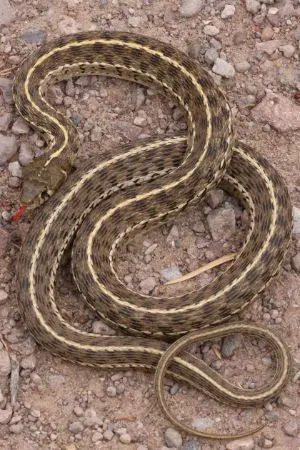
- Experience Level: Beginner
- Family: Colubridae
- Scientific Name: Thamnophis marcianus
- Other Names: Marcy’s checkered garter snake
- Adult Size: 18-24 in
- Lifespan: 7 years
- Price Range: $25-$100
The checkered garter snake has a brownish-gray base color with tan to cream lateral lines running from its head to its tail. But what really makes this species stand out is the checkered pattern created by a series of dark-brown to black blotches.
The checkered garter snake usually lives near the water. This is also the likely reason why its geographic range in Arizona has been expanding. From the southeastern corner of the state, the species follow the ever-expanding irrigation systems deeper into AZ.
Checkered garter snakes will eat basically anything they catch – mice, toads, birds, frogs, fish, and earthworms. However, the species seems to rely on this diverse diet, since they will often refuse to eat only mice if kept as pets.
37. Black-Necked Gartersnake

- Experience Level: Beginner
- Family: Colubridae
- Scientific Name: Thamnophis cyrtopsis
- Other Names: blackneck garter snake
- Adult Size: 20 in
- Lifespan: 4 years
- Price Range: $45-50
The black-necked garter snake inhabits southeastern and central Arizona. It prefers desert scrub, grasslands, and woodlands and can be commonly found near water. It is usually active during the day and in the evening. It spends its winters hibernating, and it mates in spring and summer.
The black-necked garter snake has three distinct cream-colored or tan lines. The middle one, which can be slightly darker, runs along its back, while the other two are to the side and blend into the belly. Just behind its dark-gray head is a black blotch, which earned it its name.
Blackneck garter snakes are not picky eaters. They feed on tadpoles, earthworms, fish, salamanders, and so on. They have even been seen feeding on species of tadpoles that have potent toxins on their skin.
38. Western Terrestrial Gartersnake

- Experience Level: Beginner
- Family: Colubridae
- Scientific Name: Thamnophis elegans
- Other Names: N/A
- Adult Size: 18-41 in
- Lifespan: 2 years
- Price Range: $20-$300
This species mostly lives around waterways, ponds, and lakes. In Arizona, it is commonly encountered in the northern, central, and western parts of the state. There are two subspecies living in these areas – the wandering garter snake and the Arizona garter snake.
In appearance, the western terrestrial garter snake is pretty similar to other garter snakes. It is usually darker in color, with one yellow or tan line running along its back, and one bright line on each side. It may or may not have other markings depending on the subspecies.
The western terrestrial garter snake has mildly venomous saliva, but it is mostly harmless to humans. This venom is used to subdue smaller prey, such as mice. However, this is also the only type of garter snake known to constrict its prey (although not too effectively).
39. Smith’s Black-Headed Snake

- Experience Level: Intermediate
- Family: Colubridae
- Scientific Name: Tantilla hobartsmithi
- Other Names: southwestern black-headed snake, Smith’s blackhead snake
- Adult Size: 8 in
- Lifespan: N/A
- Price Range: N/A
Smith’s black-headed snake is easily recognizable – it is of solid brown to light brown color, with the exception of its head, which is darker. There is also a lateral pink or red stripe running along its belly.
Both its Latin and common name are an homage to Hobart M. Smith, a zoologist who described over 100 new reptile and amphibian species in America. In fact, this is only one of six species of animals named after him.
Smith’s blackhead snake is very shy and is mostly active at night, which makes it a rare sight. Also, this is the reason why we still don’t know much about the species. What we do know is that it has mildly venomous saliva which is ineffective on mammals (including humans), but does work on arthropods such as centipedes and spiders.
40. Western Threadsnake

- Experience Level: Intermediate
- Family: Leptotyphlopidae
- Scientific Name: Rena humilis
- Other Names: western blind snake, western slender blind snake
- Adult Size: 12 in
- Lifespan: N/A
- Price Range: N/A
If you have ever wondered what would happen if a snake and a worm had a baby, the western threadsnake is the answer. In fact, if you ever encounter the species, you will probably think it is a worm. However, if you take a closer look, you may notice two dark spots on its head – that is where the eyes used to be.
The western threadsnake mostly lives underground and yes, it is practically blind – it can detect light, but can’t see much else. It comes in shades of pink to brown, just like an actual worm. In fact, even its head and tail are round and worm-like.
If you’re wondering how this species is even considered a snake and not a worm, our only argument would be that it has a single scale on its head. The western threadsnake feeds mostly on termite larvae, probably because it’s too small to eat anything else.
41. Brahminy Blind Snake

- Experience Level: N/A
- Family: Serpentes
- Scientific Name: Indotyphlops braminus
- Other Names: flowerpot snake, common blind snake
- Adult Size: 2-4 in
- Lifespan: N/A
- Price Range: N/A
If you thought that a snake can’t get more worm-like than the western threadsnake, you thought wrong. On top of having the appearance of a worm, the Brahminy blind snake has other biological worm-like properties.
The species is believed to be parthenogenetic, which basically means that all individuals collected for research so far have been females. They don’t require insemination for reproduction, and all offspring are exact genetic copies of their mother – they’re basically clones.
The species is believed to be native to Africa and Asia, and it was artificially (and mostly accidentally) introduced to the rest of the world, including Arizona and other U.S. states, most likely through plant trade, which is why one of its common names is flowerpot snake.
42. Ball Python

- Experience Level: Beginner
- Family: Pythonidae
- Scientific Name: Python regius
- Other Names: royal python
- Adult Size: 45 in
- Lifespan: 10 in the wild, 20-30 in captivity
- Price Range: $100-$500
Ball pythons are yet another species not native to Arizona. They are very popular pets among snake-lovers, which is how they made their way here. Sometimes, a pet python will find a way to escape, and other times, people who didn’t know what they were getting themselves into will release pets when they can no longer care for them.
The royal python is the smallest among African python species, and like other pythons, isn’t venomous. However, if scared, they won’t hesitate to bite, and given their size, this could cause quite an injury. Much more often, if the ball python feels scared, it will roll up in a ball, with the head in the middle for protection. This is how it got its common name.
43. Sonoran Shovel-Nosed Snake

- Experience Level: N/A
- Family: Colubridae
- Scientific Name: Sonora palarostris
- Other Names: Sonoran shovelnose snake
- Adult Size: up to 17 in
- Lifespan: N/A
- Price Range: N/A
This small species has a very narrow geographic range. It is found in Mexico and the United States. In the US, it is only known to live in western Prima County in Arizona, namely the Organ Pipe Cactus National Monument. There are two subspecies.
The Sonoran shovel-nosed snake is quite colorful. It has a series of black, yellow or tan, and red bands along its body. It closely resembles the Sonoran coral snake, but unlike it, the shovel-nosed snake has a yellow nose and a yellow belly.
Sonoran shovel-nosed snakes are harmless to people. They feed on spiders, scorpions, crickets, and other insects and arthropods. They have big, grooved teeth in the back of their upper jaws. These may serve to deliver toxins to prey, although this hasn’t been proven.
44. Racer

- Experience Level: N/A
- Family: Colubridae
- Scientific Name: Coluber constrictor
- Other Names: eastern racer
- Adult Size: 20-60 in
- Lifespan: 10 years
- Price Range: $30-$40
Eastern races are a very fast-moving species and are most active during the day. They eat small rodents, amphibians, and even other snakes. There are several subspecies of eastern racers that are good climbers and steal eggs from bird nests.
The Latin name is a bit of a misnomer – eastern racers aren’t really constrictors in the way some other snakes are. They only coil around their prey to keep it in place, rather than to squeeze it to death. For the most part, they eat their prey alive.
The eastern racer is curious and very aware of its surroundings. It will sometimes raise its head above the grass to get a better view and is quick to run away if it senses danger. If they have nowhere to escape, they will fight tooth and nail (or should we say, tooth and tail?) to free themselves from the predator.
45. Striped Whipsnake
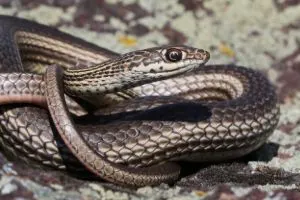
- Experience Level: Expert
- Family: Colubridae
- Scientific Name: Masticophis taeniatus
- Other Names: N/A
- Adult Size: 30-72 in
- Lifespan: 20 years
- Price Range: $50
Much like the Sonoran whipsnake, the striped whipsnake is thin and long. It is usually grey, brown, or black, and might even have a green or blue tint. It also has three lighter-colored stripes, usually gray, tan, or white.
This is a very active and fast species. It is quick to flee if it feels threatened and usually hides under rocks or in shrubs. Sometimes, it will take over rodent burrows. Speaking of rodents, they feed on mice and rats, but also lizards, amphibians, and other smaller snakes.
Striped whipsnakes aren’t too picky when it comes to their environment. They will inhabit both grasslands and pine-oak forests, mountains and flatlands, sagebrush flatlands and canyons. Basically, wherever there’s prey.
46. Chihuahuan Hook-Nosed Snake

- Experience Level: N/A
- Family: Colubridae
- Scientific Name: Gyalopion canum
- Other Names: western hooknose snake
- Adult Size: 14 in
- Lifespan: N/A
- Price Range: N/A
This is a small species that mainly inhabits the areas of western, central, and northern Texas and southeastern Arizona. It is either gray or brown in color and covered in large brown and black blotches. Its belly is cream-colored.
The snout of the western hook-nosed snake is upturned, just like in other hook-nosed snakes. Such a shape of the snout is a clear indicator that the snake is a burrower. It prefers sandy terrain and usually hides under rocks.
What makes this species stand out is its defense mechanism. When the Chihuahuan hook-nosed snake feels threatened, its first instinct is to – pass gas. This flatulence can sometimes be so strong that the snake will bounce off the ground.
47. Thornscrub Hook-Nosed Snake

- Experience Level: N/A
- Family: Colubridae
- Scientific Name: Gyalopion quadrangulare
- Other Names: N/A
- Adult Size: 14 in
- Lifespan: N/A
- Price Range: N/A
Yet another hooknose on our list, the thornscrub hook-nosed snake’s geographic range only barely touches Arizona at the very south of the state. Its background color ranges from white to cream, with rectangular blotches that are usually black. Its sides are orange to red.
The species is mostly nocturnal, although it may sometimes be seen in the late afternoon. If it gets too cold (anywhere under 80°F), the thornscrub hook-nosed snake will remain hidden. It usually feeds on crickets, grasshoppers, spiders, and scorpions.
There is a lot that we still don’t know about the species. Research indicates that females have around 2-6 eggs in a brood and that they lay them in summer.
48. Mexican Hog-Nosed Snake

- Experience Level: Beginner
- Family: Colubridae
- Scientific Name: Heterodon kennerlyi
- Other Names: Mexican hognose snake
- Adult Size: 17-24 in
- Lifespan:12-20 years
- Price Range: $100-$500
The Mexican hognose snake is among the most easily identifiable species on our list. It has an upturned nose (even more than hook-nosed snakes) and a series of light brown and dark brown blotches contrasted by a whitish background. But its most prominent feature is the shape of its head.
The Mexican hog-nosed snake’s head is short and wide (wider than its already wide body) and relatively flat. It gives off the impression that the snake is grinning. It has great eyesight and moves quickly to catch prey.
The species also has an interesting defense mechanism. First, it will inflate its body to look bigger, start hissing, and pretend to attack. If that doesn’t work, the snake will literally play dead. It will turn on its back, open its mouth, and sometimes even let its tongue hang loose for extra believability.
49. Brown Vine Snake

- Experience Level: N/A
- Family: Colubridae
- Scientific Name: Oxybelis aeneus
- Other Names: Mexican vine snake, pike-headed tree snake
- Adult Size: 6.2 ft
- Lifespan: 15 years
- Price Range: N/A
This is a long, thin species of snake that comes in shades of brown and grey with a yellow underside. It has a long, prominent head and generally resembles a twig. The inside of its mouth is completely black, which the snake likely uses to scare the predators away. Another defense mechanism it uses includes releasing a foul smell.
The brown vine snake is mildly venomous, but its venom is not harmful to humans. It is very effective on its prey, though, which mostly consists of lizards, frogs, and birds. The Mexican vine snake spends most of its time in trees and vines and is active during the day.
50. Eastern Patch-Nosed Snake

- Experience Level: Beginner
- Family: Colubridae
- Scientific Name: Salvadora grahamiae
- Other Names: mountain patchnose snake
- Adult Size: 45 in
- Lifespan: 14 years
- Price Range: $50-$100
This is a relatively long and thin snake, usually light brown or tan in color. It has two thick darker lateral lines (usually dark brown) running from its head to its tail. The underside is usually cream or whitish.
The eastern patch-nosed snake is active during the day and in warm weather. It can move fairly quickly. Its preferred environments include grasslands, rocks, canyons, hillsides, and deserts. It can even be found in woodlands.
The species feeds on small mammals, lizards, other snakes, and reptile eggs. Mothers lay eggs in spring and early summer, usually 5-10 eggs per clutch. The eggs hatch in August.
51. Green Ratsnake
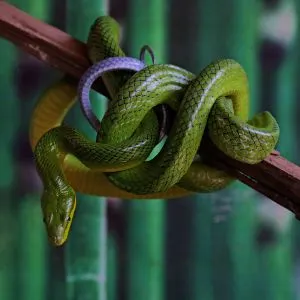
- Experience Level: Intermediate
- Family: Colubridae
- Scientific Name: Gonyosoma oxycephalum
- Other Names: arboreal rat snake, red-tailed racer, red-tailed tree snake
- Adult Size: 8 ft
- Lifespan: 20 years
- Price Range: $150-$300
The green rat snake is, well, green in color, with a tail of a darker shade of red or purple. The area in between its green scales is often black. The scales on its belly are wide and smooth which allows for easy movement in the trees.
The species spends most of its life in trees. Its green color provides for good camouflage and lets it hunt unnoticed. It mostly feeds on birds and bird eggs, but will also eat lizards and bats. Green rat snakes that are kept as pets will also settle for rodents.
The red-tailed green rat snake can be quite snappy. It is not uncommon for captive specimens to try to attack their handlers. If they feel threatened or stressed, they will inflate a sack in its neck to make themselves appear bigger and scarier.
52. Plains Black-Headed Snake
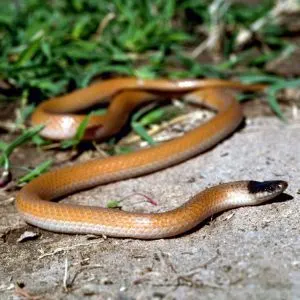
- Experience Level: Intermediate
- Family: Colubridae
- Scientific Name: Tantilla nigriceps
- Other Names: plains blackhead snake
- Adult Size: 7-12 in
- Lifespan: 4 years
- Price Range: N/A
With the exception of its head, the plains blackhead snake is pretty uniform in color – usually a shade of brown. The head, as the name suggests, is darker – usually black, and is the same width as the neck.
The species mostly inhabits valleys and semi-desert grassland, as well as hillsides with a lot of water. They are an occasional visitor in households, mainly basements where they either hide or hunt.
The plains blackhead snake is active at night when it emerges to the surface to look for food. It doesn’t handle the dry season too well and is likely to stay hidden during extended periods of drought.
53. Chihuahuan Black-Headed Snake

- Experience Level: N/A
- Family: Colubridae
- Scientific Name: Tantilla wilcoxi
- Other Names: Chihuahuan blackhead snake
- Adult Size: 14 in
- Lifespan: N/A
- Price Range: N/A
The Chihuahuan blackhead snake is the rarest type of black-headed snake in Arizona. It has a uniform tan-to-brown body, with the exception of the head and neck area. The head is, obviously, black or dark brown, while the neck has a whitish “necklace” with thin dark borders.
In the state, this species is most commonly found in the Huachuca Mountains. It also lives in canyons. It usually hides under rocks, yucca shrubs, and other plants and objects. They are considered mostly nocturnal, although we still don’t know a whole lot about the species.
It is assumed that the Chihuahuan black-headed snake mostly feeds on insects and their larvae, spiders, centipedes, and scorpions. It delivers a toxic secretion to prey, but is completely harmless to humans and won’t even attempt to bite.
54. Yaqui Black-Headed Snake

- Experience Level: N/A
- Family: Colubridae
- Scientific Name: Tantilla yaquia
- Other Names: Yaqui blackhead snake
- Adult Size: 12-13 in
- Lifespan: N/A
- Price Range: N/A
This small snake looks very similar to the previous two entries on our list. In fact, the first-ever collected specimen of the Yaqui blackhead snake in Arizona back in 1907 was initially misidentified as a plains blackhead snake.
Behind the characteristic dark brown or black head is a whitish collar which, unlike the Chihuahuan blackhead snake, doesn’t have a dark border. It also has white cheeks and either white or white-speckled snout.
In the state of Arizona, the species can only be found in Santa Cruz and Cochise counties, where it inhabits oak woodlands, although it may occasionally venture into semi-desert grasslands. It can usually be seen after rainfall when the ground is moist.
55. Mexican Gartersnake

- Experience Level: N/A
- Family: Colubridae
- Scientific Name: Thamnophis eques
- Other Names: N/A
- Adult Size: 44 in
- Lifespan: N/A
- Price Range: N/A
With the number of snake species that call it home, you’d think Arizona is a safe haven for snakes. Not for this one, though. The Mexican garter snake – namely, its northern subspecies – was placed on the U.S. Endangered Species List in 2014. The most serious threats to the species are urban development and the introduction of other exotic animals into the ecosystem.
The Mexican garter snake is a small, thick snake, usually dark brown or black in color. It has three distinctive yellow lines running from its head to its tail. It can be easily confused with the black-necked garter snake and checkered garter snake.
The species depends on the presence of water for survival and almost exclusively inhabits areas with permanent bodies of water. It feeds on frogs and fish, but won’t turn down a lizard or rodent, either.
56. Narrow-Headed Gartersnake

- Experience Level: Beginner
- Family: Colubridae
- Scientific Name: Thamnophis rufipunctatus
- Other Names: N/A
- Adult Size: 44 in
- Lifespan: 4-5 years
- Price Range: N/A
Yet another endangered species of garter snake, the narrow-headed garter snake faces the same problems as the previous entry on our list. The numbers are quickly declining, but efforts are being made to preserve and save the species.
Unlike most other garter snakes, this one doesn’t have stripes. Instead, it has dark irregular blotches. The snake is usually olive to brown, and the blotches are slightly darker. Young narrow-headed garter snakes can have a reddish tint.
Much like its Mexican cousin, the narrow-headed garter snake is semi-aquatic and mostly feeds on fish. Naturally, they are great swimmers and will often swim upstream to catch prey. It also dives underwater when it feels threatened.
57. New Mexico Threadsnake
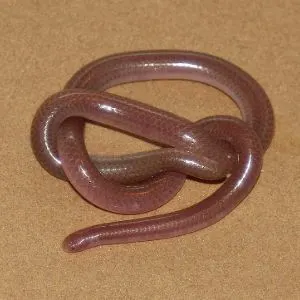
- Experience Level: N/A
- Family: Leptotyphlopidae
- Scientific Name: Rena dissecta
- Other Names: New Mexico blind snake
- Adult Size: 5-10 in
- Lifespan: N/A
- Price Range: N/A
This tiny snake is usually a uniform pink color with a rounded head and tail. At first glance, it can easily be mistaken for a worm. Unlike worms (and unlike the western threadsnake), it has scales.
Much like worms, the New Mexico threadsnake spends most of its life underground. It occasionally emerges on the surface, usually after rain. Since it has no practical use of its eyes, the species has basically lost eyesight.
The New Mexico threadsnake feeds on termites and ant eggs. There is still much we don’t know about the species, but it seems to be fairly social. There have been multiple sightings of two to eight threadsnakes hiding under the same rock.
58. Sonoran Coral Snake

- Experience Level: Expert
- Family: Elapidae
- Scientific Name: Micruroides euryxanthus euryxanthus
- Other Names: Arizona coral snake
- Adult Size: 13-21 in
- Lifespan: 18 years
- Price Range: N/A
This is one of the smallest species of coral snakes, and the only one that lives in Arizona. It has colorful bands typical of coral snakes that come in red, black, and whitish. The white bands are usually narrower than the other two.
Also known as the Arizona coral snake, the species is venomous, and its venom has neurotoxic properties. This means that it attacks the nervous system. Although the venom of this snake is very potent, there have officially been no fatalities from its bite.
The coral snake usually spends its days underground and is most active at night. It will also come to the surface after rain or during periods of high humidity. Its diet consists mostly of other, smaller snakes – usually threadsnakes. It will also occasionally eat a lizard.
59. Central Plains Milk Snake
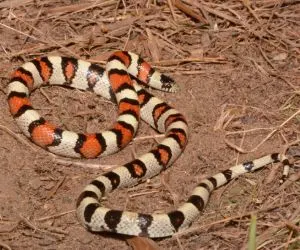
- Experience Level: Beginner
- Family: Colubridae
- Scientific Name: Lampropeltis gentilis
- Other Names: Western milk snake, Arizona milk snake
- Adult Size: 47-52 in
- Lifespan: 20 years
- Price Range: $50-$300
The Central Plains milk snake is the only type of milk snake that lives in Arizona. It looks relatively similar to the Sonoran coral snake, for which it is often mistaken. However, its black bands are much narrower than those of the Sonoran coral snake.
There is also a variety of the species in which these bands appear more as spots. Unlike coral snakes, this species is much friendlier and won’t bite humans. Their peaceful nature and colorful bodies make them a popular pet among beginner snake enthusiasts.
They generally live among rich vegetation, but can sometimes be found in rockier areas, on agricultural fields, and even in barns and homes. They feed on lizards, birds, rodents, bird and lizard eggs, and sometimes even insects.
Frequently Asked Questions About Arizona Snakes
Can you own a snake in Arizona?
Arizona is among the strictest states when it comes to laws on exotic pets. In fact, owning or trading in one of the animals that are on the prohibited list is considered a class 4 felony. Poisonous snakes, for example, are on this list, and this includes rattlesnakes, cobras, mambas, and more.
Some of these species are legal to own with a special permit. However, these permits are hard to get and are only granted for a good reason, such as rehabilitation or scientific research. On the other hand, there are some snakes that are legal to own in Arizona. These include, for example, the ball python and the reticulated python.
Are snakes a problem in Arizona?
We would refrain from calling any species a “problem”. After all, this is their planet just as much as it is ours. That being said, it is a fact that snakes are a very common occurrence all across the state. However, most species that live in Arizona shy away from people and don’t pose a threat to humans. In fact, a handful of species are great for pest control, as they feed on mice, insects, and lizards.
What kind of venomous snakes live in Arizona?
Arizona is home to a long list of snake species, some of which are venomous. These are mostly rattlesnakes (which happens to be one of the most common groups of snakes in the state), but also lyre snakes, garter snakes, vine snakes, and coral snakes.
It is important to remember, however, that not all venomous snakes pose a serious threat to humans (most don’t, in fact). Even if you run into one of the venomous species, it will likely either flee or give you warning signs before attacking. So as long as you’re careful and aren’t looking for trouble, you should be fine.
Why is it illegal to kill rattlesnakes in Arizona?
It is actually not illegal to kill rattlesnakes in Arizona. Most rattlesnake species are very widespread and aren’t considered endangered, which is usually the number one reason to criminalize the killing of a species. However, in order to be able to kill rattlesnakes legally, you either need to have a valid hunting license or do so in self-defense.
That being said, there really is no point in killing a rattlesnake. If you’re wary about snakes coming into your home or backyard, snake fencing would be a much better solution. On the other hand, a big portion of snake bites actually happen when an untrained person tries to catch or kill a snake.
What do you do if you see snakes in Arizona?
If you come across a snake in Arizona, either outside or in your own home, the best thing you can do is not touch it. Even if you’re fairly certain that the snake you’re looking at isn’t venomous, there’s no way to know for sure. After all, there are so many species that look alike.
As we’ve already mentioned, most people who report getting bitten also report having tried to kill or catch the snake when the incident occurred. So for your own safety, avoid the snake if you’re outside or call professionals if you’re inside.
Wrapping up
We hope this massive list of the 59 native snakes in Arizona was informational to say the least. Some of these will make good pets, and some are just not an option to have as pets.
We would love to know if you have come across any of these in Arizona and where you ran into them. Let us know in the comments below.
Snakes in other states

Connie Payton
Tuesday 2nd of August 2022
I’ve enjoyed this site. I’m trying to identify a small, maybe a foot long, skinny, dark gray snake that is in my garage. I tried to sweep it out but it went under a cabinet. I’m just going to leave it alone.